Royal Observer Corps
 The Royal Observer Corps (ROC) was a civil defence organisation intended for the visual detection, identification, tracking, and reporting of aircraft over Great Britain. During the Second World War, they played a valuable role as the 'eyes and ears' of the Royal Air Force (RAF) on the Romany Marsh 'Invasion Coast'.
The Royal Observer Corps (ROC) was a civil defence organisation intended for the visual detection, identification, tracking, and reporting of aircraft over Great Britain. During the Second World War, they played a valuable role as the 'eyes and ears' of the Royal Air Force (RAF) on the Romany Marsh 'Invasion Coast'.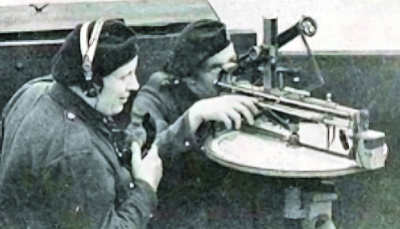

The ROC operated in the United Kingdom between 29 October 1925 and 31 December 1995, when the Corps' civilian volunteers were stood down (ROC headquarters staff at RAF Bentley Priory stood down on 31 March 1996).
Composed mainly of civilian spare-time volunteers, ROC personnel wore a RAF-style uniform and latterly came under the administrative control of RAF Strike Command and the operational control of the Home Office. Civilian volunteers were trained and administered by a small cadre of professional full-time officers under the command of the Commandant Royal Observer Corps; latterly a serving RAF Air Commodore.
In 1925 trials involving a network of observation posts linked by telephone were carried out in co-operation with the RAF to test a system for identifying and tracking enemy aircraft. The trials were so successful the Observer Corps were set up in the same year. Initially the network was confined to the Maidstone and Horsham areas but during the 1930's as the threat of war increased the Observer Corps system was extended to cover the whole of the British Isles.
The ROC played a crucial role during the Battle of Britain and no more so than on the coastline of Romney Marsh.
In 1935, an improved post instrument had been introduced and by 1938 there were about 1400 posts. When war was declared in 1939 the Observer Corps posts had been manned for two weeks. There were several such ROC posts on the coastline of Romney Marsh, including one on the roof of a Martello Tower in Dymchurch - Find out more - and its satellite post on Littlestone Greens
In 1941 the contribution made by the Observer Corps was formally recognised by the granting of the title Royal Observer Corps (ROC) by George VI who also became the first Air Commodore-in-Chief.
The ROC continued to serve throughout the Second World War. They provided early warning of air raids and later in the war helped spot incoming V1 and V2 flying bombs. Observers even served aboard the invasion fleet on D-Day to give early identification of incoming aircraft.
The V-1 flying bomb, also known as the Buzz Bomb or Doodlebug, was an early pulse-jet-powered predecessor of the cruise missiles developed by the German Luftwaffe during the Second World War.
At its peak, more than one hundred V1s a day were fired at south-east England, 9,521 in total, decreasing in number as sites were overrun until October 1944, when the last V1 site in range of Britain was overrun by Allied forces.
The V1 was first launched against Britain in June 1944, just one week after D-Day, with one of the first being sited by the Royal Observer Corps crew manning their post in Dymchurch.
The first V1 flying bomb launched against Britain was in June and was sited by the Royal Observer Corps crew manning their post on a Martello Tower in Dymchurch.
Find out more
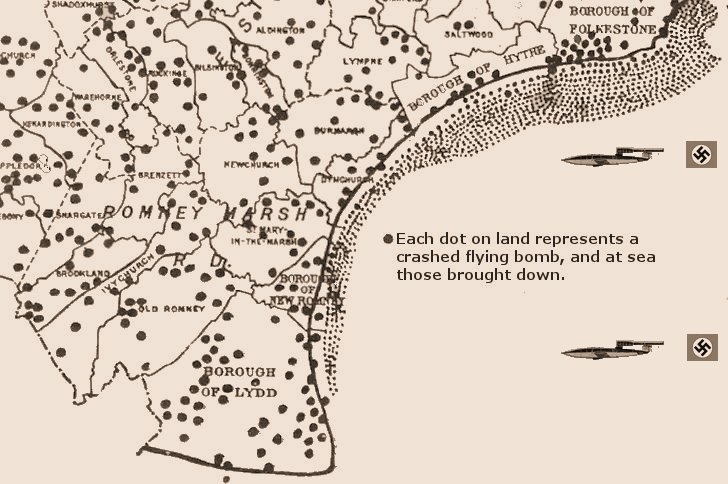
Flying bombs crashed on land and brought down over the sea, 1944
The Sighting of the First V1 in Dymchurch on 13 June 1944
On 13 June 1944, 1/M2 Dymchurch ROC Post on one of the Martello Towers was in the thick of the flying bomb activity. Observers Woodland and Wraight were on duty and they were the first Post to report a flying bomb. ![]() Find out more
Find out more
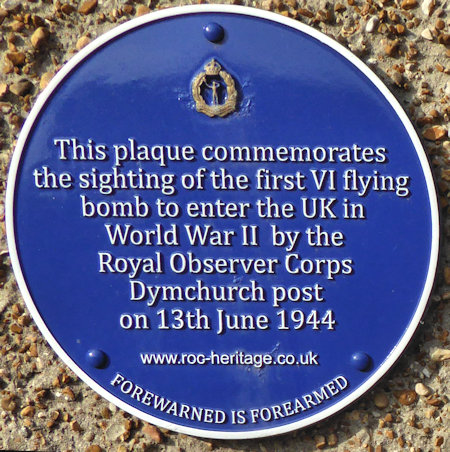
Blue Plaque on Martello24
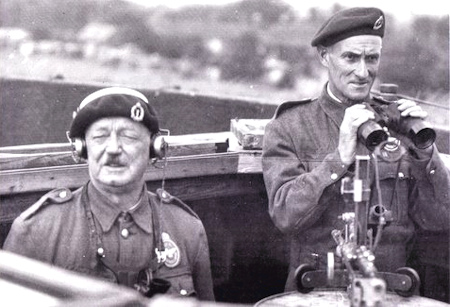
ROC on Martello Tower In Dymchurch 1944
The considered opinion is that the plaques and photo refer to Martello25
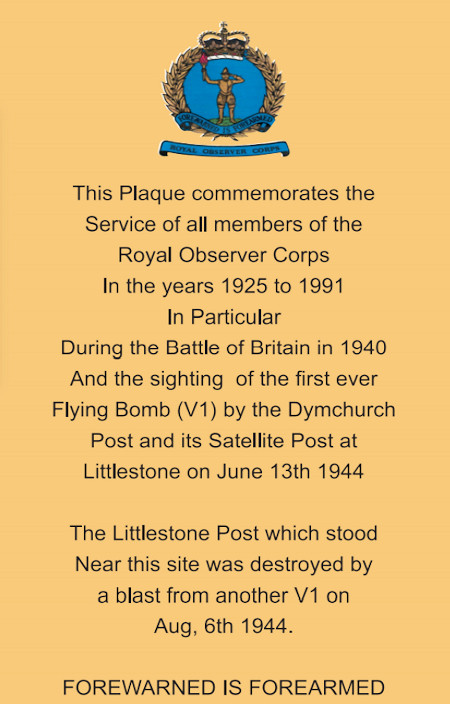
ROC Plaque at Littlestone Greens

Following the end of the Second World War, the ROC had a brief period of stand-down before it was reactivated in 1947 in response to the increased tension with the Eastern Block. By the 1950's the threat of nuclear attack persuaded the Government to set up the United Kingdom Warning and Monitoring Organisation (UKWMO).
The Royal Observer Corps was given the job of collecting information on the locations of nuclear bombs, information on weapon sizes, fallout information, and basic weather information.
To meet the Corps' nuclear reporting role, the Royal Observer Corps constructed underground structures, known as Monitoring Posts which were operated by volunteers. There were/are 3 such Monitoring Posts on Romney Marsh, at Brookland, Dungeness and Dymchurch.
In all but a very few instances, the posts were built to a standard design consisting of a 14-foot-deep access shaft, a toilet/store and a monitoring room. The most unusual post was the non-standard one constructed in a cellar within Windsor Castle.
Almost half of the total number of posts were closed in 1968 during a reorganization and major contraction of the ROC. Several others closed over the next 40 years as a result of structural difficulties, e.g. persistent flooding, or regular vandalism. The remainder of the posts were closed in 1991 when the majority of the ROC was stood down following the break-up of the Communist Bloc. Many have been demolished or adapted to other uses but the majority still exist, although in a derelict condition.
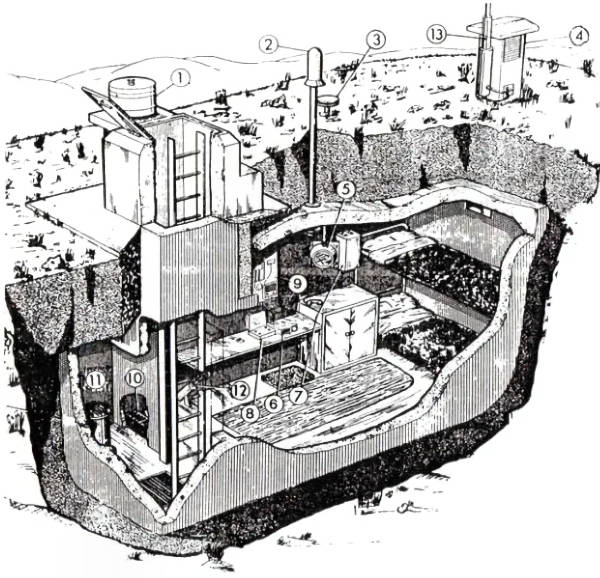
Typical ROC Monitoring Post courtesy of sync-below.com
The Brookland ROC Monitoring Post is located in a wooded area on the North side of Clubb’s Lane in Brookland. The post is in very poor condition. There is evidence of flooding and repeated vandalism. The hatch is broken and resting on the shaft itself. Internally not much remains only one bed.
Externally the post is in awful condition, soil erosion has resulted in a massive hole opening up at the base of the shaft. It appears something is living in there. The Orlit B alongside is in poor condition too, the local children appear to have converted it into somewhat of a den.
Opened in 1962 and closed in 1968.
The Dungeness ROC Monitoring Post is located in a fenced compound on Lydd Ranges on South side of Jury’s Gap Road.
Unlike other Kent posts which are entirely underground, the Dungeness post was built at or just below the surface and covered with earth and shingle making a conspicuous mound within the compound with a concrete path across the shingle and steps up the mound.
Externally and internally the post is in excellent condition with shelving, two cupboards, bedside curtains but no bunks, tool rack, weather charts, photographs and paperwork including the visitors' log.
Cellnet tried to buy the site but the MOD refused to sell at the request of Major Pat O’Reilly who feels it should be retained for heritage reasons. There are plans to repaint the post internally and re-laminate the remaining papers to preserve them.
From time to time it is used by the local police for surveillance purposes. The hatch is locked.
Opened in 1965 and closed in 1991.
The Dymchurch ROC Monitoring Post is located in a fenced compound on the East side of Burmarsh Road, west of Dymchurch village centre.
Externally the post is in good condition with some flaking of the dark green paint. The hatch is open. Internally it has suffered vandalism with a lot of rubbish left on the floor. The carpet, cupboard, and shelves remain intact.
Opened in 1962 and closed in 1991.
"There were two locations used by the ROC in Dymchurch, one during the second world war, and I was told the Martello Tower No.25 in the car park was the ROC post. And that is where Dymchurch observers correctly identified and tracked one of the first V1 flying bombs.
When the UKWMO took on the nuclear role and the bunkers were built the ROC post in Dymchurch was moved to the one on the Burmarsh road. The next nearest Westward is (was) in Northiam, north of Peasmarsh, I last attended that one in 1987.
No. 1 group Maidstone controlled the whole of Kent and some of East Sussex. 51 Post on the Crete road at Folkestone was the prime post of the 3 group cluster of 51 Folkestone, 52 Dymchurch and 53 Dungeness. Each had a telephone link to No1 Group HQ but 51 Folkestone was also a Radio Post, it had a transceiver and a hydraulically elevate aerial that could communicate with HQ by radio in case the telephone system was knocked out. Each group of 3 ROC posts had one designated as a radio post.
Dymchurch ROC volunteers used to meet on Monday evening in the post at Burmarsh to check the equipment and charge the batteries using a portable generator called the PE (Petrol electric), and establish that the CCP (Carrier control point was working) and check communications with HQ were working. At the close of the day, we would go off to the Shepherd & Crook for a pint.
The post got paid a nominal sum to cut the grass in the compound, we took turns to do it, the money was pooled and spent subsidising the annual dinner that was usually as “Cassidys cavern” in Folkestone"
ROCA Heritage is the official National Heritage Group of the Royal Observer Corps Association. Initiated in early 2011, the Group aims to promote the heritage of the Royal Observer Corps and the Royal Observer Corps Association.
The ROCA Heritage has produced two articles describing the role of the ROC in the battle against the V1 flying bombs.
![]() Diver! Diver! Diver! Hitlers's V Weapons - provides an insight into the V weapons
Diver! Diver! Diver! Hitlers's V Weapons - provides an insight into the V weapons
![]() The Sighting of the First V1 on 13 June 1944 - about the first sighting of the V1 by two ROC observers on a Dymchurch Martello Tower
The Sighting of the First V1 on 13 June 1944 - about the first sighting of the V1 by two ROC observers on a Dymchurch Martello Tower


